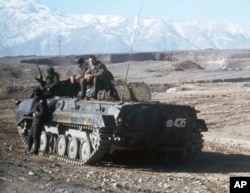On May 15, 1988, the Soviet Union began withdrawing from Afghanistan after eight years of military intervention that cost an estimated 10,000 to 15,000 Soviet soldiers their lives and killed or displaced millions of Afghans.
Soviet leader Mikhail Gorbachev described the Afghan intervention, which began in late 1979, as a costly drain on the Soviet economy with no clear victory in sight.
Soviet troops entered Afghanistan en masse in December 1979, following infighting involving communist factions that had culminated with the ouster of the country’s president, Nur Mohammad Taraki, by supporters of a more radical rival, Hafizullah Amin. The invading Soviet forces killed Amin and replaced him with a Soviet loyalist from a rival faction.
The intervention came at the height of the Cold War, with the Soviets seizing large swaths of the country. The Soviet occupation further strained relations with the United States.
President Jimmy Carter responded by implementing economic and other sanctions against the Soviet Union, as well as holding up arms control talks and barring American athletes from attending the 1980 Olympic Games in Moscow.
The U.S. armed the Mujahideen, along with other interested countries, among them Pakistan, Saudi Arabia and China.
For Afghanistan, the Soviet withdrawal did not mean an end to the fighting, however. By 1996, the strict Islamic rebels known as the Taliban, who had been trained in religious schools across the border in Pakistan, took control of the Afghan capital, Kabul.
In a twist of historical irony, the very Afghan rebels the United States armed to oust the Soviets would ultimately harbor al-Qaida, the terrorist network led by Osama bin Laden, that orchestrated the Sept. 11, 2001, terror attacks on New York and Washington.







